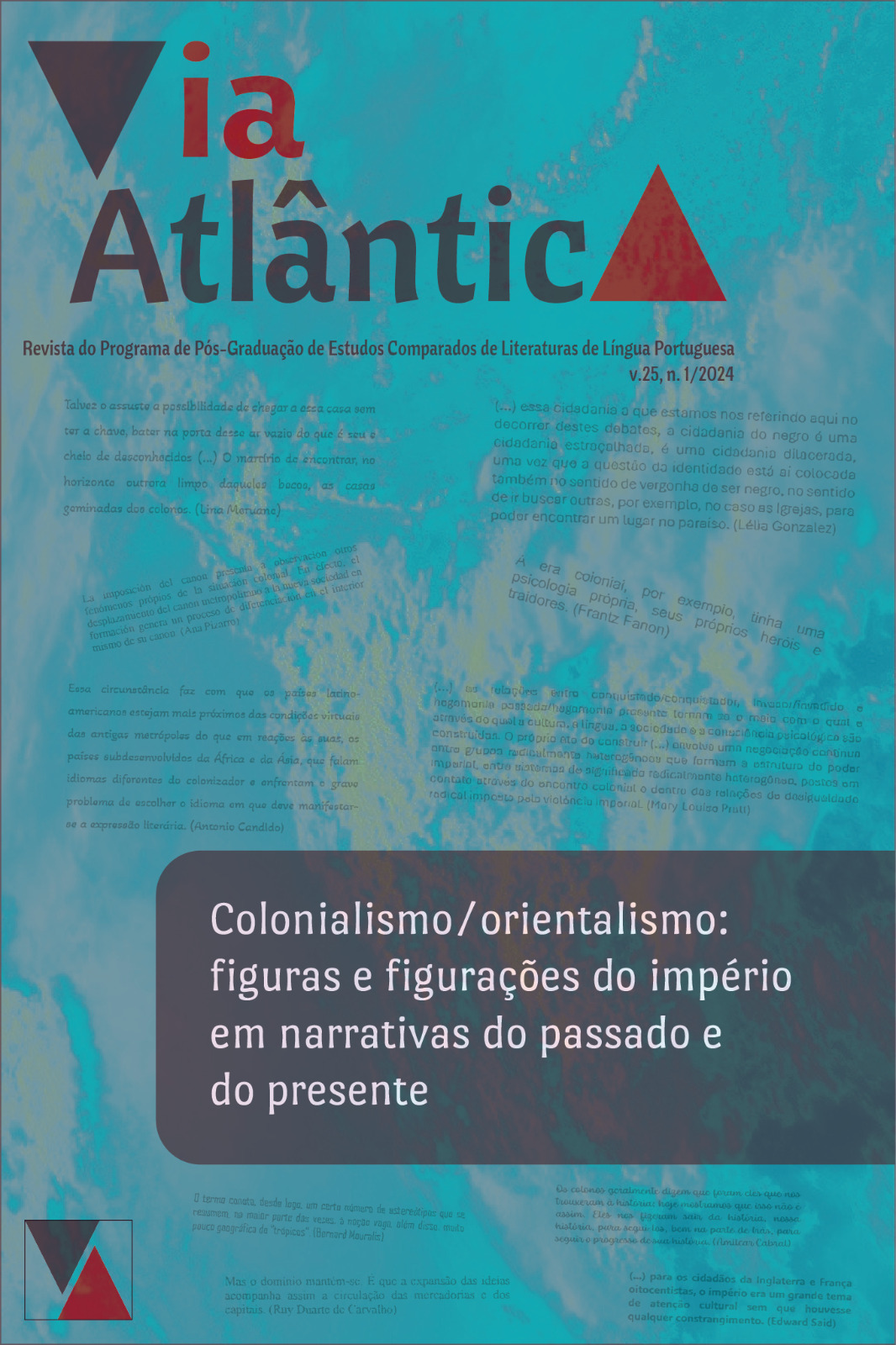A utopia do harém: representações do harém nas cartas persas de Montesquieu e em Nasci num Harém de Fatima Mernissi
DOI:
https://doi.org/10.11606/va.i1.196276Palavras-chave:
despotismo, harém, agencialidade , olharResumo
O harém tem vindo a ser, há muito, retratado como representativo do Oriente no imaginário Ocidental. Para alguns, é um lugar de despotismo e de opressão (feminina) e, para outros, uma utopia feminista de liberdade e proteção feminina. Este ensaio analisa duas obras fundamentais com enfoque no harém: as Cartas Persas, de Montesquieu (séc. XVIII) e Nasci num Harém, de Fatima Mernissi (séc. XX). O ensaio desenvolverá uma leitura comparatista e exploratória dos haréns representados nestas obras, focando-se, especificamente, nas temáticas da agência e poder, partindo dos conceitos de poder despótico, agência feminina e agência autoral e o olhar.
Downloads
Referências
ABDO, Diya M. Narrating Little Fatima: A Picture Is Worth 1001 Tales - ‘Multiple Critique’ in Fatima Mernissi’s Dreams of Trespass: Tales of a Harem Girlhood. Image & Narrative v. 19, par. 1-36, 2007. Available at www.imageandnarrative.be/autofiction/abdo.htm. Accessed December 18, 2021.
AHMED, Leila. Western Ethnocentrism and Perceptions of the Harem. Feminist Studies v. 8, n. 3, p. 521–34, 1982. Available at www.jstor.org/stable/3177710. Accessed November 11, 2021.
BOURGET, Carine. Complicity with Orientalism in Third-World Women’s Writing: Fatima Mernissi’s Fictive Memoirs. Research in African Literatures, v. 44, n. 3, p.30–49, 2013. Available at www.jstor.org/stable/10.2979/reseafrilite.44.3.30. Accessed December 17, 2021.
FOXHALL, Lin. Studying Gender in Classical Antiquity. Cambridge: Cambridge University Press, 2013.
GAIÃO, Pedro. Eunucos: Castrados pelas Igrejas e vendidos aos Árabes. História Islâmica, October 20, 2020. Available at https://historiaislamica.com/pt/eunucos-castrados-pelas-igrejas-e-vendidos-aos-arabes/. Accessed December 17, 2021.
GROOT, Joanna de. Oriental Feminotopias? Montagu’s and Montesquieu’s ‘Seraglios’ Revisited. Gender & History v. 18, n. 1, p. 66–86, 2006. Available at doi: 10.1111/j.1468-0424.2006.00415.x. Accessed December 18, 2021.
GROSRICHARD, Alain. The Sultan’s Court. European Fantasies of the East. Translated by Liz Heron. London; New York: Verso, 1998.
HATHAWAY, Jane. The Chief Eunuch of the Ottoman Harem. From African Slave to Power-Broker. Cambridge: Cambridge University Press, 2018.
HUNDERT, E. J. Sexual Politics and the Allegory of Identity in Montesquieu’s ‘Persian Letters.’ The Eighteenth Century, v. 31, n. 2, p. 101–15, 1990. Available at www.jstor.org/stable/41467743. Accessed December 15, 2021.
ISHAQUE, Nausheen. Empowerment through Disempowerment: Harem and the Covert Female Resistance in Fatima Mernissi’s Dreams of Trespass: Tales of a Harem Girlhood. Cultural Dynamics, v. 30, n. 4, p. 284–302, 2019. Available at doi: 10.1177/0921374019828855. Accessed December 22, 2021.
JUNNE, George. The Black Eunuchs of the Ottoman Empire. Networks of Power in the Court of the Sultan. London; New York: I. B. Tauris, 2016.
LEBBADY, H. Fatima Mernissi Dreams of Trespass: Self Representation or Confinement Within the Discourse of Otherness. In EDRIS M., MARK LL., and AHMED S. (eds). North-South Linkages and Connections in Continental and Diaspora African Literatures. Trenton: Africa World Press, 2005, p. 129-139.
LORAUX, Nicole. The Children of Athena: Athenian Ideas about Citizenship and the Division Between the Sexes. Translated by Levine, Caroline. Princeton: Princeton University Press, 1993.
MACDONALD, Myra. Muslim Women and the Veil. Problems of Image and Voice in Media Representations. Feminist Media Studies, v. 6, n. 1, p. 7–23, 2006. Available at doi:10.1080/14680770500471004. Accessed November 30, 2021.
MERNISSI, Fatima. Dreams of Trespass: Tales of a Harem Girlhood. Cambridge: Perseus Books, 1994.
MONTAGU, Lady Mary Wortley. Turkish Embassy Letters. London, 1763.
MONTESQUIEU. The Spirit of the Laws. Translated by Anne M. Cohler, Basia Carolyn Miller, and Harold Samuel Stone. Cambridge: Cambridge University Press, 1989.
---. Persian Letters. Translated by Margaret Mauldon. Oxford: Oxford University Press, 2008.
MOORE, L. Before and Beyond the Nation: South Asian and Maghrebi Muslim Women’s Fiction. In CHAMBERS C. and HERBERT C. Imagining Muslims in South Asia and the Diaspora: Secularism, Religion, Representations. London; New York: Routledge, 2014, p. 42-56.
MULVEY, Laura. 1975. Visual Pleasure and Narrative Cinema. Screen, v. 16, n. 3, p. 6–18, 1975. Available at doi:10.1093/screen/16.3.6. Accessed September 25, 2021.
NELSON, Christopher. The Domestic Is Political, and the Political Is Gendered: An Analysis of Veiled Subjects, Gendered Epistemologies, and Muslim Bodies. Islamophobia Studies Journal, v. 3, n. 1, p. 106–14, 2015. Available at www.jstor.org/stable/10.13169/islastudj.3.1.0106. Accessed December 8, 2021.
RENK, Kathleen. Women Writing the Neo-Victorian Novel. Erotic “Victorians”. Cham: Palgrave Macmillan, 2020.
SAID, Edward W. Orientalism. New York: Vintage Books, 1979.
SANDERS, Jennifer Epley. Resistance from Within: Power and Defiance in Montesquieu’s Persian Letters. SAGE Open, p. 1–12, 2020. Available at doi: 10.1177/2158244020951555. Accessed December 12, 2021.
SCHMIDT, Silke. (Re)Framing the Arab/Muslim. Mediating Orientalism in Contemporary Arab American Life Writing. Bielefeld: Transcript Verlag, 2014.
STILL, Judith. Hospitable Harems? A European Woman and Oriental Spaces in the Enlightenment. Paragraph v. 32, n. 1, p.87–104, 2009. Available at doi: 10.3366/E026483340900042X. Accessed November 12, 2021.
TAYYEN, Sana. From Orientalist Sexual Object to Burkini Terrorist Threat: Muslim Women through Evolving Lens. Islamophobia Studies Journal v. 4, n. 1, p. 101–14, 2017. Available at www.jstor.org/stable/10.13169/islastudj.4.1.0101. Accessed November 11, 2021.
THOMAS, Ruth P. Montesquieu’s Harem and Diderot’s Convent: The Woman as Prisoner. The French Review v. 52, n. 1, p. 36–45, 1978. Available at www.jstor.org/stable/389521. Accessed January 3, 2022.
WINKLER, John J. The Constraints of Desire: The Anthropology of Sex and Gender in Ancient Greece. New York: Routledge, 1989.
ZAHLNER, Roswitha. Strategic Auto-Exoticism: Camara Laye’s L’Enfant Noir (1953) and Fatima Mernissi’s Dreams of Trespass: Tales of a Harem Girlhood (1994). Journal of Postcolonial Writing, v. 57, n. 4, p. 539–51, 2021. Available at doi:10.1080/17449855.2021.1889642. Accessed January 4, 2022.
Downloads
Publicado
Edição
Seção
Licença
Copyright (c) 2024 Maria Francisca Bacelar Begonha de Alvarenga

Este trabalho está licenciado sob uma licença Creative Commons Attribution 4.0 International License.
Autores que publicam nesta revista concordam com os seguintes termos:
- Autores mantém os direitos autorais e concedem à revista o direito de primeira publicação, com o trabalho simultaneamente licenciado sob a Licença Creative Commons Attribution que permite o compartilhamento do trabalho com reconhecimento da autoria e publicação inicial nesta revista.
- Autores têm autorização para assumir contratos adicionais separadamente, para distribuição não-exclusiva da versão do trabalho publicada nesta revista (ex.: publicar em repositório institucional ou como capítulo de livro), com reconhecimento de autoria e publicação inicial nesta revista.
- Autores têm permissão e são estimulados a publicar e distribuir seu trabalho online (ex.: em repositórios institucionais ou na sua página pessoal) a qualquer ponto antes ou durante o processo editorial, já que isso pode gerar alterações produtivas, bem como aumentar o impacto e a citação do trabalho publicado (Veja O Efeito do Acesso Livre).






















